700 kHz.
500 kW.
100% modulation.
no limiter...
If you lived way out on a farm, you probably depended on one or more of these distant, clear-channel stations for your only night time contact with the world. They were the Class 1-A's, the superstations, the flame throwers. They had callsigns like KFI (Farm Information), KOA (King Of Agriculture), WSM (We Shield Millions), and KRVN (Rural Voice of Nebraska). There were no market areas, no Arbs, no sound-alike syndications, and no graveyard buzz from hundreds of close-sited coffee-warmers. AM was bigger stuff than that, and Ohio's WLW was the biggest.
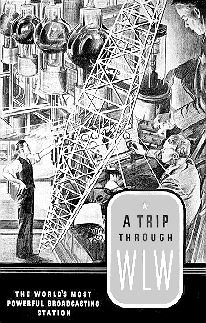
WLW was originally the extended shadow of Powel Crosley, Jr., yet another of those forgotten, 20th century visionaries. He invented things, and sold them. Lots of them. Crosley left the high end to other people, preferring simple, mass-produced merchandise with extremely attractive prices. It worked. He sold refrigerators, auto accessories, and for a time the autos to go with them. He sold a lot of them, and made a ton of money. He became owner of the Cincinnati Reds, who played in Crosley Field until fairly recently, and who still carry their games on WLW.

Crosley Radio really took off after acquiring Precision Instrument Company, a manufacturer with an Armstrong license to build super-regenerative sets. Crosley's first regens were similar to Precision's Ace, a little, battery-powered box with a peep-hole so you could look in and set the filament voltage to the single tube by eye. This evolved quickly into the ten-dollar Crosley Pup, an even smaller, black cube with the single tube poking up on top, knobs to twiddle on three sides. and a "grid leak" on the back.
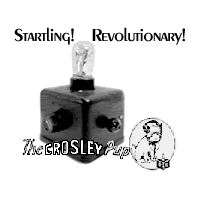
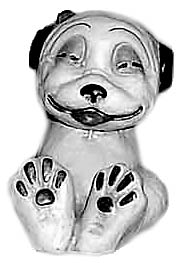
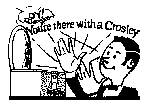
Since Crosley Pups, and regenerative radios in general, worked best on strong signals, he wanted watts. Lots of watts. He saw to it that his stations always had the highest signal strength possible. Not the highest practical - the highest possible. He was the champ photon-slinger of American broadcasting, and knew it. He liked it that way. You know. It's one of those guy things.
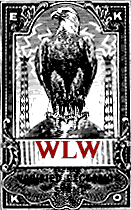
In 1928, WLW was the first U.S. station to make it to 50 kW, courtesy of an enormous, water-cooled, Western Electric transmitter, the kind with those huge, Frankenstein-ish meters on top and plenty of ominous little windows where one could look in and see how hot the tubes were getting. By then, WLW occupied the choice frequency of 700 kHz, from a majestic antenna farm near Mason, OH, just outside Cincinnati. For several reasons, this was a killer site for coverage. When darkness fell, and the band opened up, the mighty skip wave from Mason's horizontal antenna ruled the sky.
Now, 50 kW was a hell of a lot of juice in 1932. In an old-style, plate-modulated transmitter, it's still a lot of juice in 2000. Crosley, though, knew he could do better. Somehow, he finagled the Federal Radio Commission into an "experimental" authorization for 500 kW, first with the special callsign of W8XO, finally as commercial WLW.
Of course, W8XO really was an experiment, and not a cheap one. Half a megawatt, three-quarters fully modulated, millions of peak-envelope watts, on 700 kHz, with existing tube electronics, had never been tried. Building the beast required the combined engineering talents of RCA, General Electric, and Westinghouse. The investment, changed into today's dollars and at today's engineering prices, might not have been much less than a space mission, which in a way it was.

The huge, high-level modulator was also water-cooled. It could easily make 400 kW audio with both of its largely redundant modules simultaneously cranked to full rock and roll. Fortunately for the survival of civilization, this case was rare. Each module used four more of the biggest tubes made, bringing all of RCA 1's RF and AF output tube complement to twenty, with a total cost of $34,000 in 1930s' depression dollars. Even more mindboggling were the two modulation transformers, one per module, each 37,000 pounds, oil filled, and 10 feet high. It's possible that these two Westinghouse reactors were in fact the world's largest transformers for a brief time - "heavy iron" indeed!
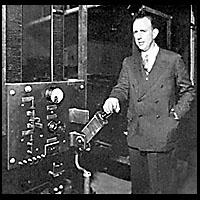
Powel Crosley
throws the big switch
A new back was built onto WLW's already spacious building, 33 kV AC service was brought in, and ultimately RCA 1 grew 15 feet tall, 57 feet wide, and something like 30 feet deep. Enclosures weren't so much cabinets as rooms, where people might explode if they contacted the wrong circuits. There was a catwalk, a balcony really, across the front of the beast, for tube access through more of those ominous, glass doors. Under the catwalk were a few meters to watch, and a lot of water faucets to turn. Inside, the rig had as many Pyrex water pipes as wires. Outside, it looked more like a nuke plant.
RCA 1, then, needed a few features we don't see much anymore. Primary cooling water came from a distillery, and was circulated through a heat exchanger in the 700-gpm pump room. Secondary water went outside, to a fountain-like cooling pond. There were so many relay-driven contactors in the Westinghouse control system that they needed another large motor-generator for coils and auxiliary circuits. Huge AC transformers, and rows of those touch-and-you-die knife switches so popular at the time, were everywhere. The whole plant looked a bit like a power station, which to some extent it was.

Of course, there had to be a new, vertical antenna, and not just anything could do a good job on the expected 70 RF amps at the current loop. Up went a beautiful, Blaw-Knox diamond, the strongest and dizziest-looking AM radio tower ever designed, reserved for only the elite of broadcasters. You've seen pictures of these. They are pointy at the bottom, big in the middle, and pointy at the top.
Contrary to folklore, the diamond shape was for strength, and it worked. An airplane hit this tower once, barely denting it. The shape actually caused some weird RF issues. These were ultimately partially resolved by taking out some of the middle.
WLW's version was an 800-foot half-wave, guyed in the middle with bridge cables. It weighed nearly a million pounds, as much as a small building, and in fact it was very briefly one of the world's tallest structures. It all bore down to a point, on one giant base insulator with an air-gap lightning arrestor. An airplane hit this tower once, barely denting it. It's still the primary antenna at WLW, shortened slightly to move a cancellation node out of populated areas.
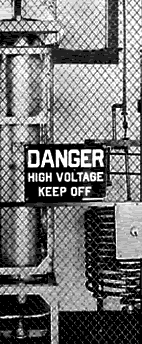
Needless to say, W8XO's late-night tests went on for months. This wasn't your mom's hot plate. When Ohio's famous lightning hit the tower, RF would simply sustain any resulting arcs, at the air gap or anywhere else, until the carrier was interrupted. There were folk tales, probably accurate, of talking rain gutters, sparking fences, singing water pipes, and nearby street lights dimming on modulation peaks.
This brings up the real fun part of 1934 AM broadcasting - NO LIMITERS! WLW, like any big-time station at the time, gave the Full Monty: 100 per cent modulation. Now, radio textbooks always have cute little pictures of sine waves at 100%, but people don't talk in sine waves. They don't beat drums, play hillbilly music, or yodel in sine waves. If the studio asked the big rig for some outrageously asymmetrical upward modulation barely crossing zero at all, the DC-sucking beast said FEED ME and obliged - briefly. Voltmeters dipped at the power company, antenna current went haywire, cows felt funny tingles in odd places, and various shotgun-loud bangs and sparks filled the transmitter building.
Operators tried gallantly to ride gain by hand, but this was still not a good place to work if you had a fear of electricity. Transmitter logs were pretty exciting reading, telling of antenna-house fires, hurried repairs on still-dangerous circuits, and rushed replacement of various melted or exploded parts.
Eventually, RCA 1 was stable enough for commercial service, or at least as stable is it was ever going to get. WLW started giving walking tours of its transmitter. Wires were rented, straight to the White House, for a grand opening live on the air.
On May 2, 1934, anticipation mounted as Eleanor Roosevelt sang the praises of technology and world understanding. Back at WLW, a warning klaxon echoed through the buildings, as pumps and generators came up to speed. Outdoors, in the pond, water fountains began to spray. In the filament room, bells rang as operators zapped those big switches into place. In the contactor room, huge relays banged closed. The vast plant came alive. It was ready. And then, at 9:30 Central, came the moment of an engineer's lifetime, as FDR, the President Of The United States for Chrissake, ceremoniously pressed the same golden telegraph key that Wilson had used to open the Panama Canal....

The President and First Lady had forgotten about the transmitter's hard-programmed, 30-minute warmup every time B+ was cycled. The great beast came on-air, all right, but when it was darn well ready. At long last, though, a new signal lit up the air worldwide. It soon became clear that its potential night coverage was global, propagation and power supplies permitting. Crosley's popular "Moon River" program took one request from Buckingham Palace, England!
Engineers later added a manual button to hot-start the transmitter. If the tubes were warm, this greatly cut downtime. If the tubes were cold, it cut the throat of whichever clown just blew up one of the world's most expensive rectifier banks.
WLW's advertising rates jumped 10 dB right along with the signal. The station ate money, but it made it faster. Much faster. Everyone wanted to pitch half the known world on a superpower, The Nation's Station, Whole Lotta Watts, World's Largest Wireless, The Voice From The Sky, the flame thrower, the mighty mike heard in London.

Seeing this high-voltage profit potential, fifteen other US stations filed for 500 kW. None were authorized. Soon, bitter competitors turned up the legal heat on WLW. Crosley couldn't build a cooling pond for that one. Twice a year, he and his lawyers would sweat, argue, present, plead, and wheedle an ever more hostile FCC into yet another 6-month extension of the experimental authorization.
Several stations complained of adjacent-channel interference. WLW briefly returned to 50 kW at night, to protect a station in Canada. The solution was one of the earliest known anti-skywave phasers. Two towers went up on the farm across the street to the north, fed by trolley car wire, to cancel out high-angle radiation in that direction. It worked, and WLW resumed full power. Too bad Crosley couldn't null out the US media lobby so easily.
In 1938, the US Senate got into the radio consulting business, something Congress seems to have done periodically ever since. They passed the Wheeler Resolution, "asking" the FCC for an absolute limit of 50 kW. WLW's next renewal was denied. After a year of intense court battles, the station exhausted all appeals, and shut down the huge amplifiers, except for brief, experimental night periods as W8XO. Crosley noted, bitterly, that 50 kW wasn't that many more horsepower than a couple of speeding Buicks. (He was right, in fact, though it's still an awful lot of RF.) It wouldn't even make coffee as far as he was concerned. The law, however, was the law.
Super-power was not the only Crosley project. Another one, starting in 1939, was radiofacsimile. This was the "READO" system, using patents licensed from Finch Telecommunications. The name presumably meant radio that you read instead of heard.
The FCC allowed AM stations to transmit FAX between midnight and six AM. Crosley offered a home FAX machine, in a plain woodgrained box, and an optional extra timer to turn it on while people slept. Daytime FAX was possible too, over stations on the high HF/ low VHF range, with a separate receiver and antenna.
This system scanned printing AND photographs on strips of paper just under 5 inches wide. It used a photocell on a rapidly oscillating arm, deriving sync from the AC current. A synchronized arm, again using the AC, recreated the pictures on rolls of treated paper in the receiver. The quality was actually pretty good, better and more permanent than the first grungy thermal faxes sold to consumers for telephone use.
At its peak, something like 13 stations had made arrangements to carry this service. It continued on WLW until early in World War II. Crosley also advertised a receiver in kit form for hams who wanted to experiment with this mode.
In a rather prophetic advertisement, Crosley stated that, "Eventually we believe that every home will be equipped to receive sound, facsimile, and television." 65 years later, it looks as if we're nearly there.

"Experimental" W8XO actually did some serious work, greatly improving RCA 1's power and reliability. By the end of World War II, the beast could easily make a megawatt if it had to, and it loafed along at 600 kW. There must have been some very interesting nights in Mason. The wartime government liked this just fine, considering The Nation's Station an important part of the nation's defense, ready to address the whole country at once in an emergency. With this as a selling point, WLW filed for a return to commercial super-power several more times, right up until the 1960s. It was always denied.
We mentioned before that several other stations had filed for super-power before the Wheeler Resolution put the lid on at 50 kW. One of these, WJZ in New Jersey, had actually ordered a 500 kW RCA transmitter. It was a modernized version of WLW's rig, still using 3 PA's in Class C and two high-level modulators in Class B, all water cooled. In this case, though, the 50 kW exciter was also contained in the transmitter, making for a rather awesome row of equipment.
WJZ never got permission to operate this flame thrower, and it remained mothballed at the RCA factory. When World War II came, the British government bought this transmitter for 112,000 English pounds, no small change in 1941. It was modified at the factory for a nominal 600 kW, at that time more than WLW/W8XO. The whole thing was then shipped off and installed in a huge, underground bunker near Crowborough, UK, where it became part of a super-power mediumwave site codenamed "Aspidistra." This was a reference to a popular Gracie Fields song, "The Biggest Aspidistra in the World." (When "Aspidistra" is not suggesting a part of the human anatomy, it's a rather unexceptional house plant with big leaves.)
Aspidistra was also specially re-engineered to be extremely frequency-agile. While most super-power mediumwave transmitters required modification and/or extensive re-tuning to change frequency, this one could jump all over the band at will. Its first task was as a BBC relay that could also be used as a jammer, by synchronizing the frequency with German MW stations and overpowering their signals.
However, the British Political Warfare Executive ultimately used the Aspidistra for "Black" Propaganda, a tactic in which the other side's own broadcasts are spoofed in order to gain trust and plant false or subversive information. For the remainder of the war, Aspidistra's high power and versatility were used extremely cleverly to inject bogus messages to German troops or civilians. Some broadcasts were even in Hellschreiber, an otherwise exclusively German teleprinting mode which produced hard copy on long, thin rolls of yellow paper.
The war also brought considerable change back in Mason, OH. For one thing, it got Crosley into the super-power business on short wave. WLW had experimented considerably with this mode all through the 30s, first as W8XAL, then as WLWU, WLWK, and the historic WLWO. After Pearl Harbor, U.S. non-government shortwave broadcasting was closed down, but the Office of War Information still saw a need to compete with the huge short wave stations being used by the enemy.
Once again, RCA, GE, and Westinghouse were called together. Someone mentioned that Crosley Radio had the real smarts both with super-power and short wave, and they were invited to the meetings. This was lucky, as it turned out. The OWI radio planners asked if anyone thought they could get to 200 kW, on HF, from six transmitters, by 1944. Crosley Radio, being a smaller, more focused company, was the only one that could meet the challenge without hurting wartime efficiency in other areas.
Once again, Mason was a great site. It was well back from the coasts, always a strategic advantage, and as a bonus it hit all of Latin America with no skip zones. At war's end there were five stations there, each with a WLWx call, each with a custom-built, Crosley transmitter. Three of these were 200 kW, one was 50, and WLWO carried on with 75.
Once again, the technical problems were horrendous. New tubes had to be designed for 50 kV RF voltages. High-gain rhombic antennas, the standard at the time, had to be improved for efficiency, not to mention fire safety. Advances had to be made in the fairly arcane art of "re-entrant termination," a scheme that let these antennas throw some real juice without simply melting. Switching between the resulting acres of carefully aimed and tuned rhombics was a nightmare, using open wire lines and long rows of pole disconnects that had to be operated by hand in all weather. Birds landing on these lines had a tendency to explode, simply vanish into very small pieces.
After the war, these stations became an important part of the US Information Agency's Voice Of America. In 1954, VOA moved to a heroic antenna farm in Bethany, the next little farm town over. For a very brief time, the Bethany complex was the world's most powerful short wave station. The 200 kW Crosleys were installed in a formidable row. With their catwalk and glass doors, they looked more than a little like good old RCA 1.
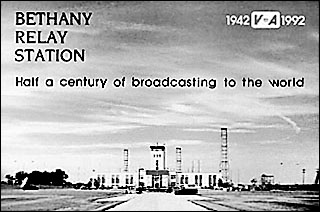
Bethany remained a key VOA site, often still using the proud callsign WLWO, until the end of the Cold War. Huge Sterba curtain antennas sprouted among the rhombics, and rows of giant Collins and Brown-Boveri transmitters replaced the old Crosleys.
Unfortunately, the VOA budget was shredded in the mid-90s, and the service came under considerable bureaucratic attack. Bethany, which was nearing the end of another expensive upgrade, was suddenly shut down, amid a huge controversy. Antennas were demolished for scrap, and some of the land was sold off to developers. Today, West Chester Township and a veterans' group are raising money to restore remaining portions of the site, including the old transmitter building and its guard tower, as a museum.
Meanwhile, back at WLW, the engineers weren't exactly sleeping. They kept the venerable, 50 kW, 1927 Western Electric going, decade after decade, modernizing its insides a number of times. In 1959, though, it got a friend. Legendary engineer R. J. Rockwell got Crosley interested in high-fidelity AM. They sprung some big bucks for a custom-built "Cathenode" transmitter, with a special modulator operating in class AB. This box was flat from 20 to 20 kHz audio, maximum 1% distortion, fed by one of the world's first microwave studio/transmitter links. WLW might not be able to call itself the world's largest AM station anymore, but it could sure advertise that it was the cleanest.
Crosley invited McIntosh Laboratories, the hi-fi tuner people, to check it all over, and indeed WLW was certified as up to state of the art. McIntosh noted that the signal actually measured better than several FM stations. Obviously, the bandwidth was pretty wide, but nobody complained. Remember this the next time someone says AM can't deliver high fidelity!
The rig, though, was understandably very inefficient. When hi-fi AM went nowhere, it was converted to the standard class B modulation. It remains usable today. Meanwhile, the old WE carried on. It outlasted Crosley Radio itself, which was sold to Avco Electronics for a bundle. In 1975, though, after almost half a century, it was finally retired for a 50 kW, screen-modulated, Continental 317c1, which became the primary transmitter. This gave WLW three completely usable 50 kWs.
Today, the mighty Blaw-Knox spits photons from yet another 50 kW, the fourth on the site. It's a new, solid-state, class D, all-digital, Harris box, a real nice rig, if a bit dull by comparison. It's about the size of a walk-in refrigerator, with no external modulator to leak PCB, and it's extremely efficient. As always at WLW, we're talking about the state of the art.

A custom-built switching system allows instant connection from the primary Blaw-Knox, or a recently added backup tower, to any of the four working transmitters. Meanwhile, way out of sight in the back of the building, the 500 kW monster remains amazingly intact. It's in good shape, considering. The huge modulation transformers have been drained of PCB, a few parts are a bit rusty, and the catwalk is a tempting place to store things. Most of the huge tubes, though, are still clamped into place, as if awaiting the cool surge of the water and the order again to hurl lightning.
No surprise, then, that WLW saw the year 2000 in right. The chief engineer checked everything over, replaced one bad tube, and brought up the 70-year-old Western Electric. Fed through WLW's Orban audio processor, it sounded great. The station went out on it from 10:45 PM local time to 12:15 AM in the new year. The news announcers found this out, and talked it up. It was also noted how much more quietly water-cooled transmitters operate than new ones with air blowers......
Radio will survive.
- My WLW Photo Gallery
- Official Newsradio 700 WLW page
- Barry Mishkind's WLW Super Station Tour
- Dick Reiman's WLW History
- John Price's WLW History
- Jim Hawkins' WLW Transmitter Page
- Jim's Crosley Antique Radio Page